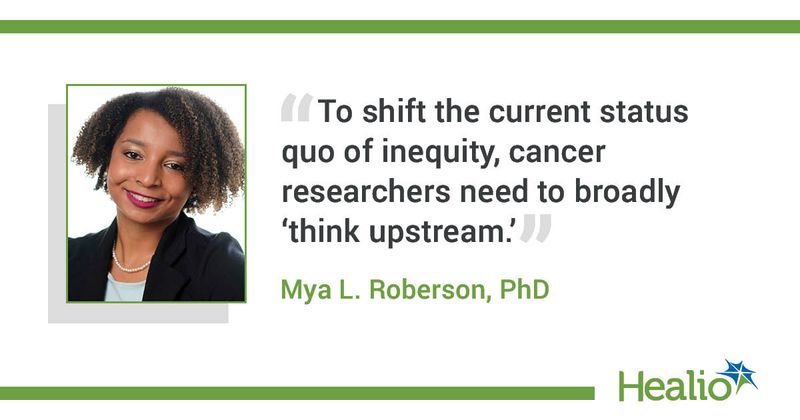Critical race theory in cancer research: Ask yourself ‘who is missing’
Critical race theory originated in a legal framework but has implications in the conduct of cancer research, according to Mya L. Roberson, PhD.
Roberson, assistant professor in the department of health policy at Vanderbilt University School of Medicine, outlined the historical and contemporary place of critical race theory in cancer research inclusive of basic, clinical, translational and population health sciences in a commentary published in Nature Reviews Cancer.

“It is especially important to understand that cancer inequities start so much earlier than when individuals are diagnosed with cancer,” Roberson told Healio. “Quite frequently, inequities have to do with where individuals live, the type of facilities they have access to and their environment.
“Understanding these broader contextual factors that go on to impact the care that individuals receive and their ability to adhere to various treatment regimens and to receive high standard of care is critical,” Roberson added. “To shift the current status quo of inequity, cancer researchers need to broadly ‘think upstream.’”
Roberson spoke with Healio about her paper, why it is important to bring this information to light and the need to rethink cancer research.
Healio: What prompted this paper?
Roberson: I am a social epidemiologist and cancer care delivery researcher, and I gave a talk in October at University of Iowa Holden Comprehensive Cancer Center where I essentially laid out my theoretical framework for how I think about cancer research overall and specifically my own work in cancer care delivery and equity. Luckily, one of my professional peers attended that talk and encouraged me to write up my theoretical framework. My colleague suggested that it could be helpful for others to conceptualize why we see cancer inequities across the board.
Healio: What is the HeLa cell line and where did it originate?
Roberson: Henrietta Lacks was a poor Black woman diagnosed with metastatic cervical cancer in the early 1950s. When she received treatment for her cervical cancer, her cells were taken without her consent and given to a researcher to use in his lab. The HeLa cell line became the first immortalized cell line and has led to a number of discoveries both inside and outside of cancer, including the discovery of HPV-associated cervical cancer. The HeLa cell line fundamentally changed medical science overall and specifically cancer research as we know it.
But Henrietta Lacks knew nothing about her cells being taken during her treatment and neither did her family for many years after that. This immortalized cell line has led to Nobel prizes, commercialization and various scientific discoveries without proper attribution for a very long time to Henrietta Lacks herself and to her family. It is sobering to think about how much we know about cancer research has its origins in something that we now deem unethical.
Healio: What should oncologists do to prevent this from happening again?
Roberson: The first step is to acknowledge that cancer research and biomedical research broadly have an unsavory past, and we need to be open to talking about this. Fortunately, we have the appropriate policies and protocols in place to ensure that things like this exploitation of Henrietta Lacks never happen again. Oncologists should understand that processes contributing to cancer inequities start long before patients even walk into their clinics. They should also understand the broad history of our field and how that has led to differential outcomes between people of color and white individuals.
Healio: How can our readers rethink cancer research and what specifically is needed in clinical trial development?
Roberson: One thing that can fundamentally change clinical trial research is thinking about inclusion from the start and not getting to the end and then realizing the study did not accrue people of color. This is a broad issue in cancer research and an issue in observational epidemiologic and cancer behavioral studies, as well. Not enough attention has been paid to the people these trials and research represent. One of the things I have found particularly illuminating early on in my career is engaging with patients directly, especially patients of color, as many want to take part in research. Sometimes, we as researchers can have biases in terms of who wants to take part in research — beyond just enrolling them in clinical trials. Having patients of color providing input on study design and getting them involved in the recruitment phase and thinking about how to best reach them are key. We are experts in cancer research and patients with cancer are experts at living with cancer. The entire cancer research enterprise could be strengthened with broader engagement of individuals living with cancer. This will make clinical trials more inclusive and diverse and will enable the broader reach of different patient populations.
In a grand sense, my ultimate hope for this paper is to challenge how we think about cancer research. One of the most flattering things that I can hear, particularly from my clinical colleagues, is that they now pay better attention to who is missing from their studies and from the literature that they are reading. If I could challenge readers to rethink one thing, it is to ask yourself this question about your clinic, your research and about the clinical guidelines: Who is missing from those? How do we include those individuals in our work, clinics and care to ensure that we are not happy with the status quo and that we move the needle to foster more equitable cancer outcomes across all populations?
For more information:
Mya L. Roberson, PhD, can be reached at mya.l.roberson@vumc.org.

